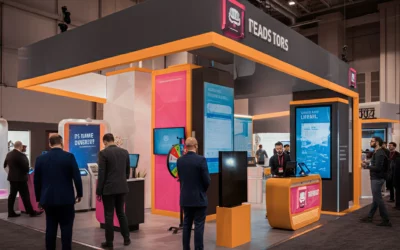The Green Events & Innovations Conference was recently held on March 2 nd, bringing together industry leaders, professionals, governments and organizations who are all looking for ways to bring environmental awareness and sustainability to the live events industry.
I suppose if we wanted to find a silver lining to Covid-19, we could say the pandemic was one of the greenest
initiatives that could have happened to live events.
Thanks to lock downs, we saw a moratorium on in-person events and a sudden spike in virtual events. And virtual events means no travel, no hotel stays, no catering, etc. so a far lesser carbon footprint for each attendee.
But with the vaccines being rolled out, life is slowly returning to normal. Many in the industry are now planning hybrid events, which include in-person components. Soon (fingers crossed), we’ll be able to plan fully live, in-person events like in the ol’ days.
How can we try and keep our event’s environmental impact to a minimum? How can we ensure our event isn’t a major source of waste?
By following some “event greening” best practices.
How Green Events Can Help Your Organization
We know why green events are good for the environment, but how exactly do they help you?
After all, if you’re going to put in the effort to “green up,” you want to know what’s in it for your bottom line. Well it turns out, plenty!
Climate change and the depletion of the Earth’s natural resources are topics that are on most people’s minds these days. Just as it’s important that each individual do their part to improve the situation, it’s equally important that organizations also pitch in.
When brands begin to embrace
sustainability and make it a part of their company culture, consumers take notice.
For instance, more and more event sponsors are looking to align themselves with those companies who have gotten onboard the event sustainability train. In addition, publicizing the fact your event is green by adding information on your website and in your marketing campaigns
is a great way to attract more attendees.
With that said, let’s dive into some of the ways you can make your events greener.
And I want to point out up front that your event budget might not stretch far enough to make your ENTIRE event sustainable.
That’s okay.
Making any sized change is enough to make a positive impact to the environment and to the perception of your brand!
1. Venues and Suppliers
Obviously the venue you choose will have a profound impact on your event’s level of “greenness.”
If you can, choose a venue that has LEED (Leadership in Energy and Environmental Design) certification. LEED venues meet incredibly strict standards of energy- efficiency and waste-reduction that will help you offset your event’s carbon footprint.
Another way to go green is to choose a local venue. Keeping your event close to home will require less travel for your attendees.
Be sure to look for venues that are close to public transport as well.
Along with choosing the right venue, be sure to choose your suppliers wisely as well. Speak with any providers about the efforts they take to reduce waste.
If you work with a 3 rd party event planner, be sure you are on the same page with them so they can make green choices whenever possible on your behalf.
2. Catering
If your event will use a caterer, opt for one that makes sustainable food made from local organic ingredients. In addition to the specific food being served, give some thought to packaging.
While it may be tempting going the easy route and using paper or plastic plates, utensils and straws, all of that adds up to a LOT of waste.
Your best options are to use non-disposable items or compostable utensils and dishes.
And one final note, go with a caterer who donates any leftovers to a local shelter. You’ll prevent waste and help your local community at the same time.
3. Décor
Decorations and signage have got to be some of the biggest waste at events. Typically, these items are made especially for the event and then discarded afterwards.
Green event design and decorations require a bit more creativity. For example, look for items that can be reused for themed events. Go for signage and décor made from recycled or recyclable materials.
And instead of buying cut flowers, which will only last for a day and then die, opt for living plants that guests and staff can take home and enjoy.
4. Go Paperless When Possible
Beyond foregoing paper plates, there are other ways you can limit event waste.
For instance, if you haven’t already, consider adopting an online booking system that allows attendees to RSVP online and allows you to issue electronic tickets and use only digital forms of communication.
And, for those things that absolutely need to be printed, there are plenty of green options available. For starters, be sure to use double-sided printing when possible.
There are also sustainable printers who use vegetable inks and low-volatility organic compounds, as well as recycled paper.
5. Carbon Offsetting
Most events, even green ones, will have some unavoidable waste. You can counterbalance this waste by carbon offsetting, that means to invest in environmental projects that lower carbon
emissions.
This can reduce your organization’s overall carbon footprint.
For instance, you can donate to a tree-planting group. One Tree Planted is a great organization to consider.
The Wrap
As we enter the post-Covid era, it’s important that we all look for ways to keep our event’s footprint small. As I mentioned a while ago, if you can’t go 100% green, that’s okay.
Do what you can now and look for ways to improve as you go. And if you need any help with planning an environmentally friendly event, please reach out to us by clicking here.
You might also like…
Top 10 U.S. Meeting Destinations for 2026
Successful corporate events don’t just happen — they’re built on smart decisions, starting with...
The Trade Show Prep Guide: Boost ROI Like a Pro
Trade shows are a powerful way to elevate your brand's visibility, connect with potential...
President’s Club 2026 Ultimate Gift Guide
Luxury, Personalization, and Impact for Unforgettable Incentive Travel President’s Club isn’t just...
The Role of Corporate Event Managers is Evolving
Corporate events aren’t what they used to be. Gone are the days of basic cocktail hours and...
Revitalizing Sales Kickoffs: Strategic Insights for 2026
Gone are the days when Sales Kickoffs (SKOs) were just annual corporate pep talks. Today's SKOs...
Planning for Performance: The 2026 Guide to Mastering Incentive Travel
Here's Why Incentive Travel is Your Secret Weapon in 2026... Gone are the days when incentive...







